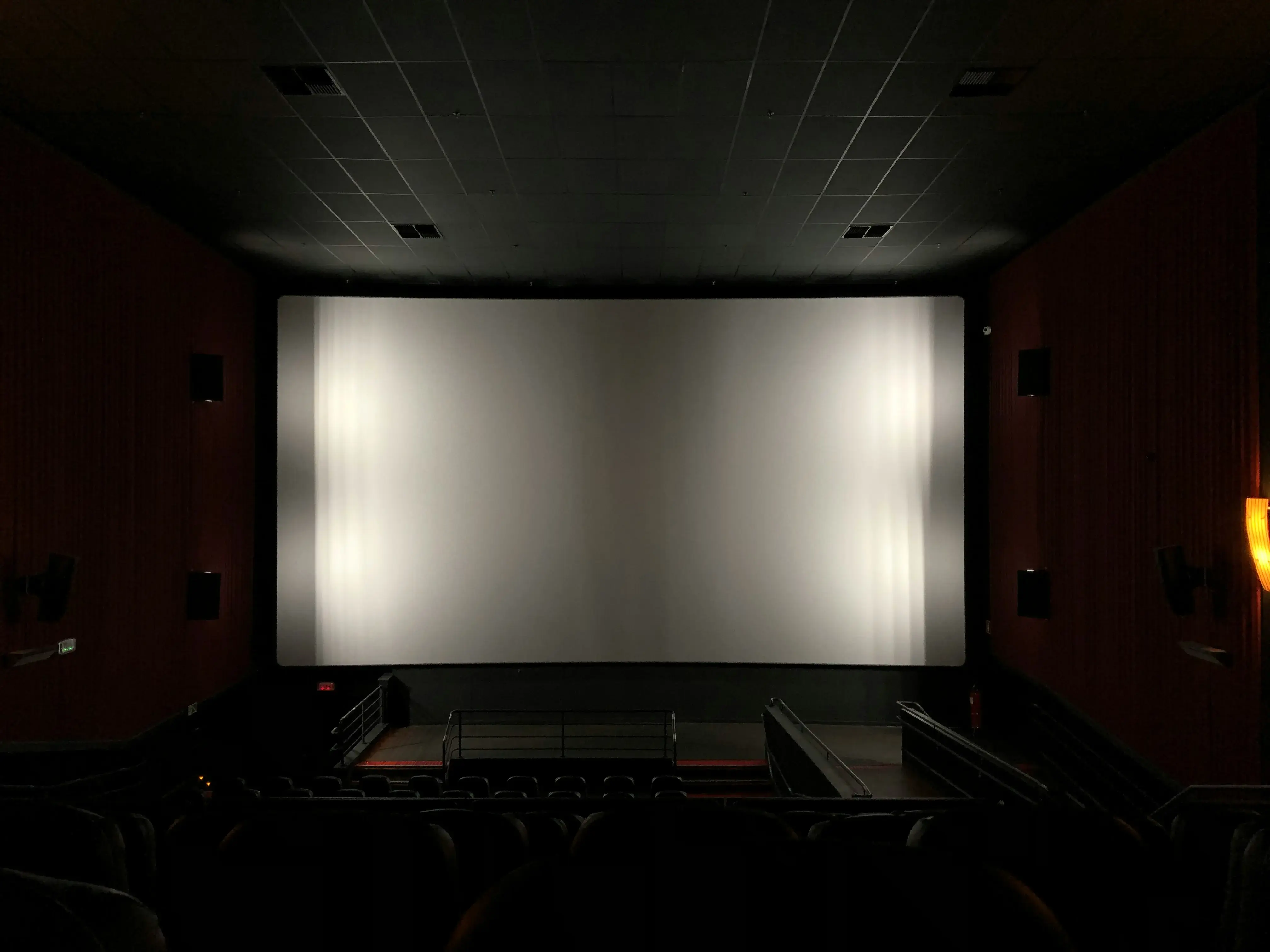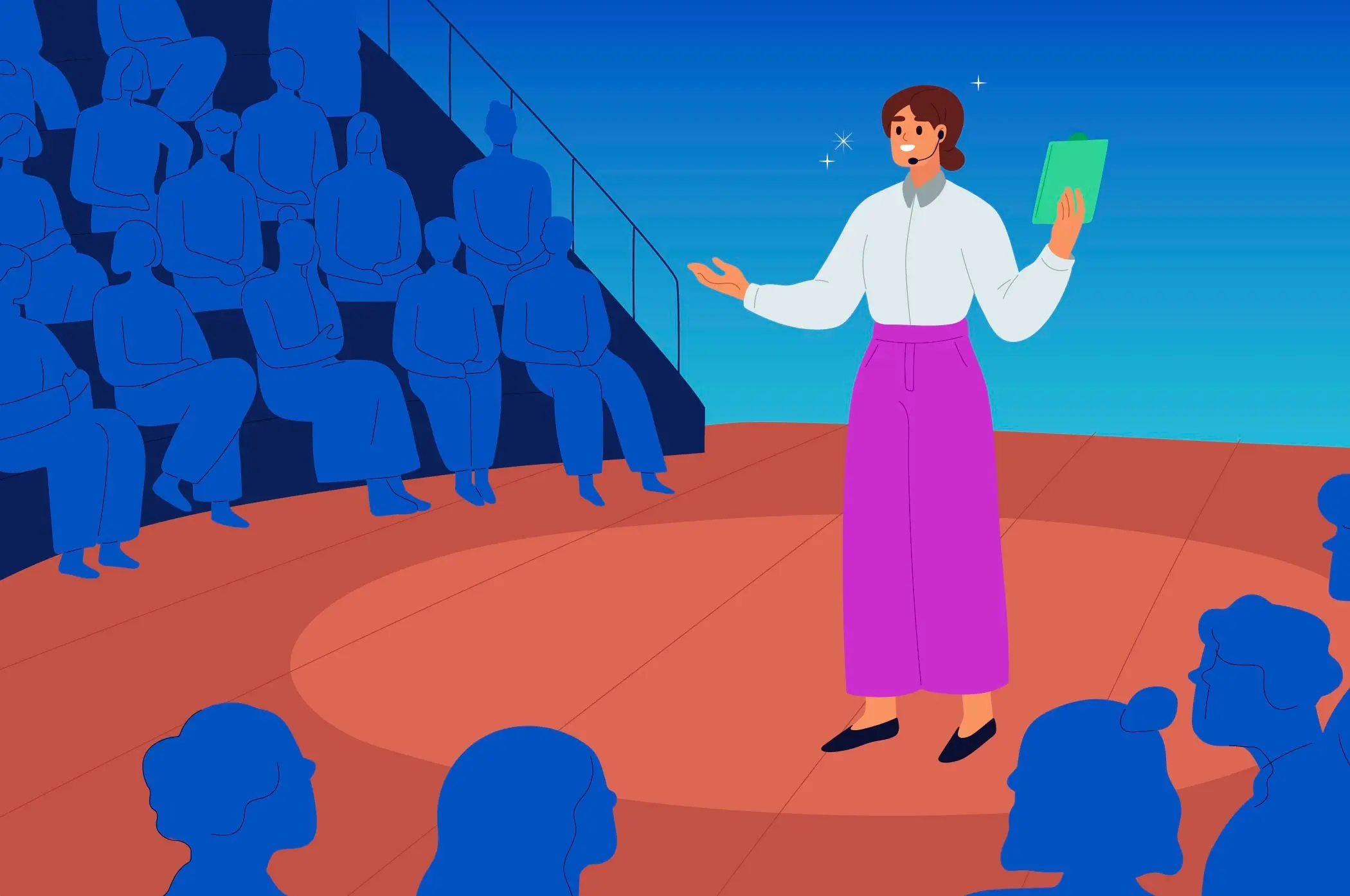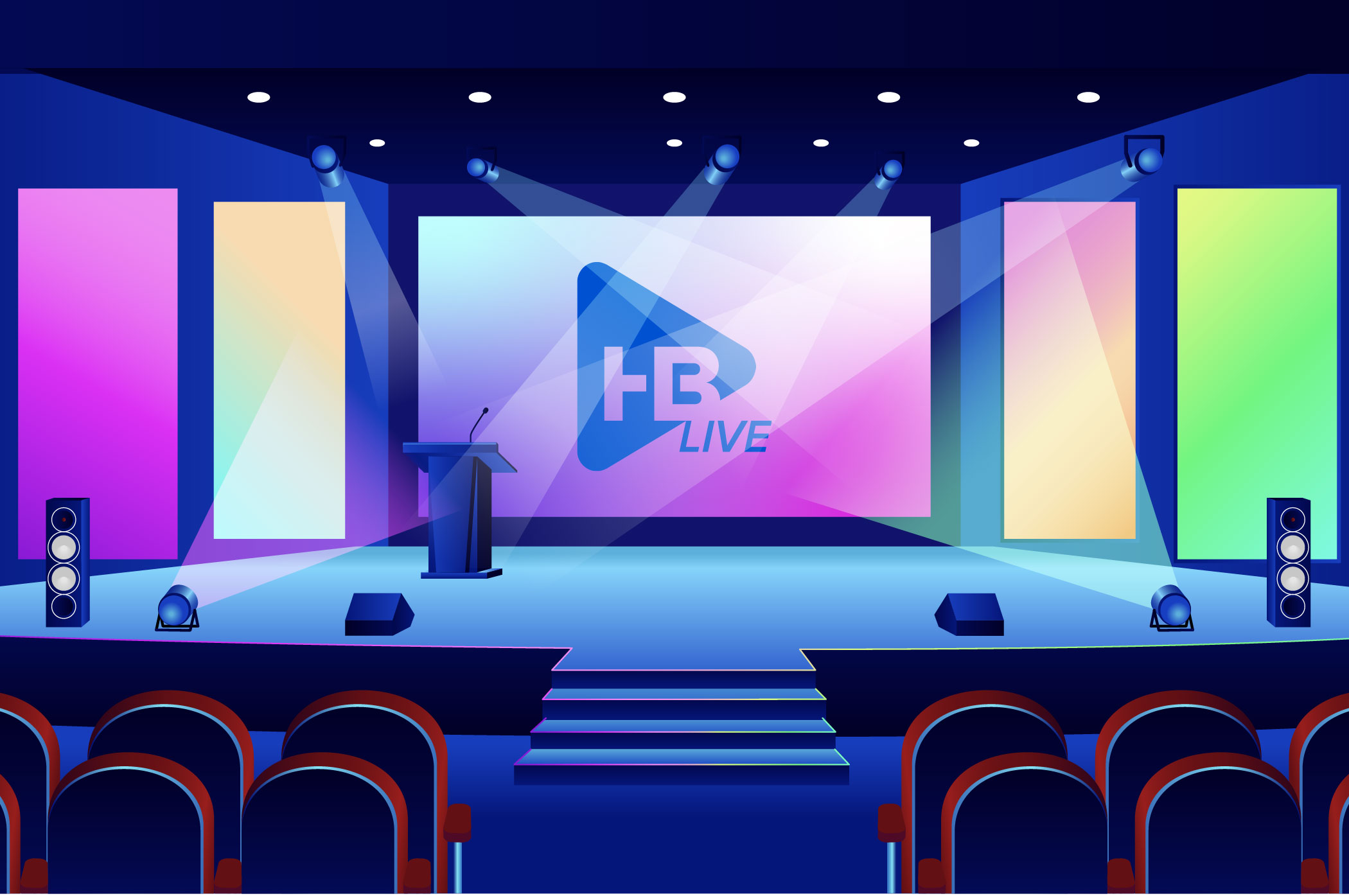Why the Right Screen and Tech Matter For Your Event
Choosing the right projection screen is critical for delivering sharp visuals and a seamless audience experience. The screen's size, material, and format can dramatically impact how clearly your visuals are seen and how immersive your event feels.
Paired with the right projector, a properly sized and placed screen transforms content into a high-impact focal point, whether you're hosting corporate training, a product launch, or an outdoor film screening. Inadequate screen choice—like poor material reflectivity, incorrect brightness levels, or wrong aspect ratio—can lead to washed-out images, awkward sightlines, and disengaged viewers.
Beyond clarity, the right projection system helps convey professionalism, brand quality, and attention to detail. For events with keynote speakers, multimedia storytelling, or live demonstrations, the visual impact plays a key role in overall engagement and retention.
Types of Projector Screens
Fixed Frame Screens
Fixed frame screens are permanently tensioned onto a frame and mounted in a set position. They’re ideal for venues with dedicated presentation spaces like boardrooms, auditoriums, and high-end home theaters.
- Crisp image quality with zero wrinkles due to a taut screen surface
- Available in various materials and aspect ratios
- Seamless viewing for high-resolution content
Because they're static, fixed-frame screens are best used in venues where AV is a permanent feature or used frequently.
Portable Folding Screens
These freestanding screens fold into compact carrying cases, making them perfect for travelling presenters, rental AV setups, or pop-up events. Generally referred to as “fast fold” screens.
- Lightweight and easy to transport
- Quick setup without needing wall or ceiling mounting
- Suitable for breakout rooms, small conferences, or temporary venues
Available in standard sizes and height adjustable to suit the venue or audience sight line. Typically surrounded by a fabric “dress kit” which might be available in a variety of colors..
Manual and Motorized Pull-Down Screens
Mounted to ceilings or walls, these retractable screens are excellent for multi-use spaces where you need AV flexibility. Manual versions use a pull cord, while motorized models offer push-button or remote control convenience.
- Available in a wide range of sizes
- Discreet when retracted—perfect for aesthetic-sensitive venues
- Excellent for offices, classrooms, or multi-purpose meeting spaces
Motorized versions are particularly well-suited to modern boardrooms or training centers that demand tech integration with minimal setup time.
Inflatable or Outdoor Screens
Designed for large-scale or open-air events, inflatable screens are engineered for durability and scale. As the name suggests, these all-in-one systems are inflated and secured to the ground with spikes or ballast.
- Support large audience sizes (hundreds or thousands)
- Cost-effective alternative to similar size outdoor LED Walls
- Typically made from weather-resistant vinyl or nylon
These screens are best suited to after-sunset film festivals, community movie nights, sporting events, and outdoor brand activations.
Ultra-Wide & Blended Screens
Ultra-wide or blended screens offer an immersive, panoramic experience by either using a single ultra-wide format or blending multiple projectors onto a straight or curved surface.
- Excellent for immersive brand storytelling or command center-style setups
- Ideal for mapping content across multiple zones
- Special content must be produced for custom aspect ratio
These are typically used in huge General Sessions or Immersive Presentations where visual wow factor is desired.
Screen Material and Gain
What Is Gain?
Gain measures the screen's reflectivity. It determines how much light is bounced back to viewers and affects brightness and viewing angles.
- Gain 1.0: Neutral, suitable for most uses
- High gain (>1.2): Brighter image but narrower viewing cone
- Low gain (<1.0): Softer brightness but wider visibility
Choosing the right gain helps balance screen visibility across the room, especially in wide audience layouts or unconventional venues.
Materials for Ambient Light Conditions
Selecting the right material is key when dealing with different lighting environments:
- Matte white: Best for dark, controlled environments—accurate colors, wide viewing angles. This is the most commonly available material for front projection.
- Grey screens: These translucent screens are used for rear projection.
- ALR (Ambient Light Rejecting): Specialized surfaces that block side light while maintaining brightness—great for mixed-use venues
The more control you have over ambient light, the more options become available. Projectors and screens must ultimately be brighter than the light in the room.
Beyond Screens: Projection Mapping for Architectural Displays
Projection mapping is a cutting-edge AV technique that transforms architectural surfaces, like building facades, into dynamic storytelling canvases. Instead of projecting onto a traditional screen, content is mapped onto the physical features of a structure using high-lumen projectors.
- Applications: Ideal for product launches, cultural festivals, holiday campaigns, or brand activations in public spaces
- Technology Requirements: Ultra-bright projectors (typically 20,000+ lumens), media servers, content creation tools, and experienced technicians
- Surface Consideration: The building or structure itself serves as the projection surface, so brightness, throw distance, and angle alignment are critical
Projection mapping requires close collaboration between content designers and AV specialists to ensure seamless synchronization, spatial alignment, and audience impact. While more complex than standard projection, it delivers unmatched visual immersion and memorability.
Matching Screen Size and Setup to Your Event
Screen Size and Aspect Ratio
Selecting the proper screen size ensures your content is legible and proportioned appropriately.
Common aspect ratios:
- 4:3 (Standard): Traditional slides, legacy content
- 16:9 (Widescreen): Modern presentations and videos
- 21:9 (Ultra-Wide): For cinematic effects and immersive displays
For most business presentations and hybrid events, 16:9 is the best fit. For highly visual installations or wide rooms, 21:9 may enhance engagement.
How to choose a size:
- Consider the furthest viewer’s distance and divide by 6 to determine the optimal screen height
- Match the aspect ratio to your content to avoid letterboxing or distortion
Larger isn’t always better. If a screen is too big for the space or mounted too high, it can reduce visibility and viewer comfort.
Venue and Audience Layout Considerations
Your screen must work in harmony with your space. Consider:
- Front vs. Rear projection: can projectors be hidden behind the screen, or do you need that room space
- Ceiling height: Limits how large a screen can be without obstructing views
- Room brightness: Affects screen material and projector brightness choices
- Audience seating: May require multiple screens
Screens placed off-centre or without proper elevation can result in reduced impact and visual strain. Early venue assessments ensure proper screen positioning.
Choosing the Right Projector Technology
DLP vs. LCD
DLP (Digital Light Processing) projectors work by shining a light source onto a chip made up of thousands (or millions) of tiny mirrors, each representing one pixel. These mirrors rapidly tilt toward or away from the light to create images through reflection. The light is often filtered through a spinning color wheel to generate full-color visuals.
- Pros: High contrast, sharp images, minimal maintenance
- Cons: Slightly weaker color saturation, potential rainbow effect in low-end models
LCD (Liquid Crystal Display)
LCD (Liquid Crystal Display) is one of the most common projection technologies used in event AV setups.
LCD projectors use a lamp that shines light through three liquid crystal panels—one each for red, green, and blue. These panels modulate the light to form the final image that’s projected onto the screen.
- Pros: Richer color accuracy, better for detailed graphics and photography
- Cons: Requires more frequent maintenance and cleaning
DLPs are popular in large event production, while LCD projectors are often used in educational or smaller-scale corporate environments.
Resolution Options: HD, WXGA, WUXGA, 4K
Choosing resolution impacts clarity, especially on large screens.
- HD (720p/1080p): Suitable for casual video content and small-scale meetings
- WXGA/WUXGA: Common in professional settings—ideal for presentations and mixed media
- 4K UHD: Required for ultra-sharp visuals, large-scale displays, or premium experiences
For events involving live demonstrations, text-heavy presentations, or design reveals, higher resolution ensures better legibility and detail.
Brightness (Lumens)
Projector brightness is measured in lumens and should align with your event conditions and screen size. As a very basic rule of thumb, assuming a relatively dark presentation space:
- 8-foot wide screen: 7,000 lumens
- 12-foot wide screen: 10,000 lumens
- 16-foot wide screen: 16,000 lumens and more
Overestimating brightness won’t hurt, but underestimating it will. It’s not uncommon to use 20,000 to 30,000 lumen projectors in large environments.
Lens Options
- Short-throw: Enables large images in tight spaces—great for rear projection or small breakout rooms
- Long-throw: Designed for projecting over long distances with minimal image distortion
- Interchangeable lenses: Allow for flexibility across different room configurations
Professional AV setups often use interchangeable lens systems to adapt quickly to varying room sizes and content formats.
Matching Screens and Tech to Event Types
Outdoor Events & Festivals
- Screen Type: Inflatable or heavy-duty portable
- Aspect Ratio: 16:9 for video content
- Projector: 16,000+ lumens, weatherproof enclosure if needed
- Screen Material: Durable, outdoor-rated vinyl
These environments require rugged, scalable solutions that withstand wind, light, and large crowds.
Conferences & Training Events
- Screen Type: Portable or motorized pull-down
- Aspect Ratio: 16:9 to match laptops and modern content
- Projector: LCD, 7,000 to 12,000 lumens or more
- Screen Material: Matte white for indoor clarity
These events benefit from quick setup, reliable performance, and screens that support both visuals and slide-based training.
Product Launches & Trade Shows
- Screen Type: Ultra-wide or edge-blended displays
- Aspect Ratio: 21:9 or custom configurations
- Projector: High-contrast DLP, 4K, 20,000+ lumens or more
- Screen Material: High-gain for dramatic visuals
These visually driven events demand immersive, high-brightness projection to impress attendees and attract crowds.
Private Functions
- Screen Type: Discreet pull-down or elegant framed screen
- Aspect Ratio: 16:9 for video montages or presentations
- Projector: Quiet model, 6,000 lumens or more
- Screen Material: Matte white or decorative wraps
Private functions value aesthetic cohesion, so screen selection should enhance the décor rather than dominate the space.
Conclusion
Selecting the perfect projection screen requires more than picking a size, it’s about aligning technology, venue, and audience needs to create a polished and impactful experience. From screen type and material to projector brightness and lens selection, each choice plays a vital role in how your content is received.
At HB Live, we specialize in helping clients make those decisions with confidence. As AV specialists, we guide you through every step, from screen sizing and projector matching to on-site setup and live support, ensuring a seamless execution every time.
Whether you're hosting an intimate function, a high-profile product launch, or a large-scale conference, our experienced team ensures your visuals are sharp, your audience is engaged, and your message is unforgettable.






